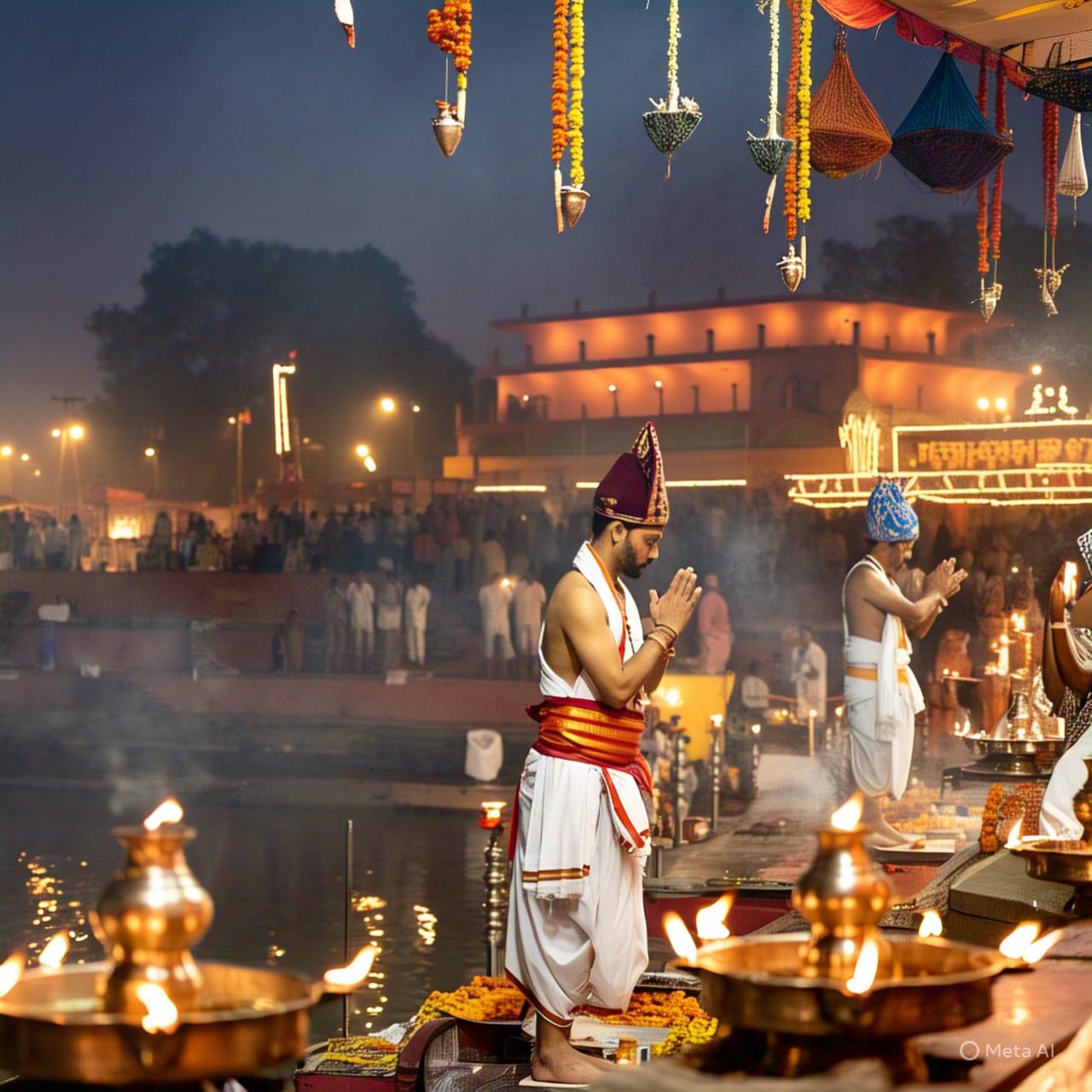Aarti at Prayagraj Ghats
As dusk descends over the ancient city of Prayagraj, the sacred ghats along the riverbanks transform into a celestial stage. The rhythmic chants, the scent of incense, the glow of countless lamps, and the synchronized rituals performed by priests—this is the Ganga Aarti, a mesmerizing spiritual spectacle that unites faith, devotion, and heritage in a single, unforgettable evening.
In this guide, we delve deep into the spiritual experience of witnessing the Aarti at Prayagraj Ghats, especially at Saraswati Ghat, and why it is an essential part of your journey to this sacred land.
Aarti at Prayagraj Ghats

What Is Ganga Aarti? A Ritual of Divine Connection
The Ganga Aarti is a sacred fire offering ceremony performed at dusk to honor Maa Ganga, the goddess of the Ganges River. Rooted in Vedic tradition, it symbolizes the gratitude of the devotees for the life-giving and purifying power of the river.
The aarti at Prayagraj is distinct from those in Varanasi or Haridwar, offering a more serene, intimate atmosphere while maintaining its grandeur and spiritual depth.
Where to Witness Aarti in Prayagraj
1. Saraswati Ghat – The Primary Venue
Saraswati Ghat, located near the confluence of the Ganga and Yamuna, is the most prominent and well-organized location for the evening aarti. Built with broad steps, clean surroundings, and an amphitheater-style layout, this ghat offers an ideal setting for both devotees and visitors.
Highlights:
- Panoramic views of the river and skyline
- Synchronised rituals by multiple priests
- Excellent space for sitting and observing
2. Dashashwamedh Ghat (Prayagraj)
Not to be confused with the Varanasi ghat of the same name, this ghat in Prayagraj carries mythological significance and occasionally hosts smaller, more intimate aartis during festivals or on full moon days.
The Rituals: Aarti Flow & Meaning
The aarti ceremony typically begins at sunset, following the setting of the sun over the river horizon.
Sequence of Events:
- Chanting of Vedic Hymns: Priests begin with the chanting of mantras to invoke the presence of the river goddess.
- Lighting of Lamps: Large multi-tiered brass lamps are ignited, symbolizing divine light and energy.
- Circular Movements: Priests wave lamps in synchronized, circular motions while bells and conches are blown.
- Floral Offerings & Diyas: Devotees float small leaf boats with candles and flowers into the river.
- Blessings & Prasad Distribution: The ceremony concludes with the distribution of sacred prasad and blessings.
Every gesture in the aarti is a devotional offering—a blend of fire (agni), water (jal), sound (nada), and devotion (bhakti).
Music, Chants & Devotional Vibes
The atmosphere during aarti is electrifying yet deeply spiritual. The sounds of conch shells, temple bells, and the collective chants of “Har Har Gange” reverberate across the ghats, creating a cosmic rhythm that immerses every soul present.
Live bhajans (devotional songs) are often sung before and after the ceremony, performed by local musicians and spiritual groups.
Best Time & Tips for Visitors
Best Time to Attend:
- Daily Aarti Time: Starts around 6:30 PM to 7:00 PM (varies by season)
- Best Months: October to March – pleasant weather and clearer skies
- Festive Days: Kartik Purnima, Magh Mela, and during Kumbh Mela the aarti is even grander and draws thousands.
Pro Tips:
- Arrive 30–45 minutes early to get a good viewing spot.
- Dress modestly and respectfully.
- Carry a mat or shawl to sit comfortably on the steps.
- Mobile phones and cameras are allowed, but flash photography is discouraged during rituals.
Devotee Participation: Feel the Divine Energy
One of the most beautiful aspects of the aarti at Prayagraj is that you don’t just watch it—you become a part of it.
- Float a diya: Offer your prayer with a lit lamp on a leaf boat.
- Join the chants: Participate in singing “Om Jai Gange Mata” with fellow devotees.
- Receive blessings: Priests often bless visitors with holy river water and prasad.
Special Aartis During Major Events
1. Kumbh Mela Aarti
During the world-famous Kumbh Mela, the aarti becomes a grand ritual with hundreds of priests, elaborate fire displays, and massive crowds. Attending the Kumbh Ganga Aarti is a once-in-a-lifetime experience.
2. Magh Mela Aarti
Held every year in January and February, Magh Mela aartis are smaller but equally sacred. Ideal for those looking for less-crowded spiritual intensity.
Beyond Aarti: Evening Spiritual Life at the Ghats
Post-aarti, the ghats come alive in a different way. Devotees continue with evening prayers, yoga, meditation, and silent contemplation. Local vendors sell prayer items, religious books, and sacred souvenirs, adding to the spiritual ambiance.
Street musicians may be heard singing Ram dhun or Bhagavad Gita shlokas, adding to the divine vibration.
Aarti from the Water: Boat View Option
For a truly unique perspective, watch the aarti from a boat anchored mid-river. The reflections of fire lamps on the Ganga, coupled with the sound of conches and chants echoing across the water, make for a magical and deeply moving experience.
Boat rides for this purpose are available from the Sangam and Saraswati Ghat areas. Charges vary from ₹300–₹800 depending on group size and boat type.
Nearby Attractions to Combine with Aarti Visit
- Akshayavat Tree – The immortal banyan tree in the Akbar Fort complex
- Hanuman Mandir (Lete Hue Hanuman) – A must-visit temple right near Saraswati Ghat
- Allahabad Fort – Historical architecture overlooking the Sangam
- Bade Hanuman Ji Temple – Perfect for a pre-aarti darshan
Conclusion
The Aarti at Prayagraj Ghats is not just a religious ceremony—it is a divine performance of faith, a symphony of devotion, and a celestial connection that touches every heart present. Whether you are a spiritual seeker, a curious traveler, or a culture enthusiast, this ritual will leave you with a sense of peace, awe, and spiritual elevation that words often fail to capture.
Make sure to include this mystical evening in your itinerary—it is the soul of Prayagraj, expressed in flames, chants, and unshakable belief.





